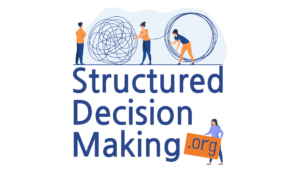Separating means from ends
Mind your means and ends
It is important to separate objectives into fundamental objectives (which reflect the ends we are trying to achieve) and means objectives (which are the possibly ways of achieving them). For example, “minimize illegal hunting of eagles” may be important, but primarily because it impacts the eagle population. “Minimize illegal hunting” is thus a means objective; “Minimize probability of extirpation of wild eagles” is likely the fundamental objective. Means objectives can lead you to identify good alternatives. Only fundamental objectives should be used to evaluate alternatives. If you include both in your set of objectives, you are likely to double-count.
How to Separate Means and Ends
Consider for example, that a participant starts with a positional statement (e.g., “we should increase the reed coverage on the lake to 20%”). In what is sometimes called The Why Game, the analyst simply repeatedly asks the question ‘why is that important?’ A fundamental objective is an objective for which the answer to “why is that important?” is, simply, “because it is”.
“We should increase the reed coverage of the lake from 10% to 20%”
“Why is that important?”
“To provide habitat for dragonflies and other insects and to provide cover”
“Why is that important?”
“Because dragonflies are an important food source for fish, and the cover reduces predation”
“Why is that important?”
“Because we want to protect native fish from extirpation”
“Why is it that important?”
“Because — it just is!” (Fundamental objective reached)
It’s helpful to illustrate the relationship between means and ends visually. Means-ends diagrams show at a high level the relationship between policy alternatives (means) at one end and fundamental objectives (ends) at the other. They are useful for developing a conceptual understanding of a system, for helping separate interests (objectives) from positions (means), and for identifying potential performance measures. Influence diagrams are similar, usually more detailed tools for illustrating cause and effect relationships.
Means or ends? Context matters!
What is a means in one decision may be an end in another. It all depends on your decision frame. If a decision has already been made to invest in an upgraded wastewater treatment plant, then a fundamental objective may be related to maximizing discharge quality. But if the decision frame is broader, for example developing a comprehensive plan to address concerns about the aquatic ecosystem, then improving municipal discharge quality is one means, to be evaluated against other means, of supporting aquatic ecosystem health.
Key Ideas
- A fundamental objective is an end that you are trying to achieve
- A means objective is a way of achieving an end or fundamental objective
- Focusing on ends rather than means helps find creative solutions to problems

